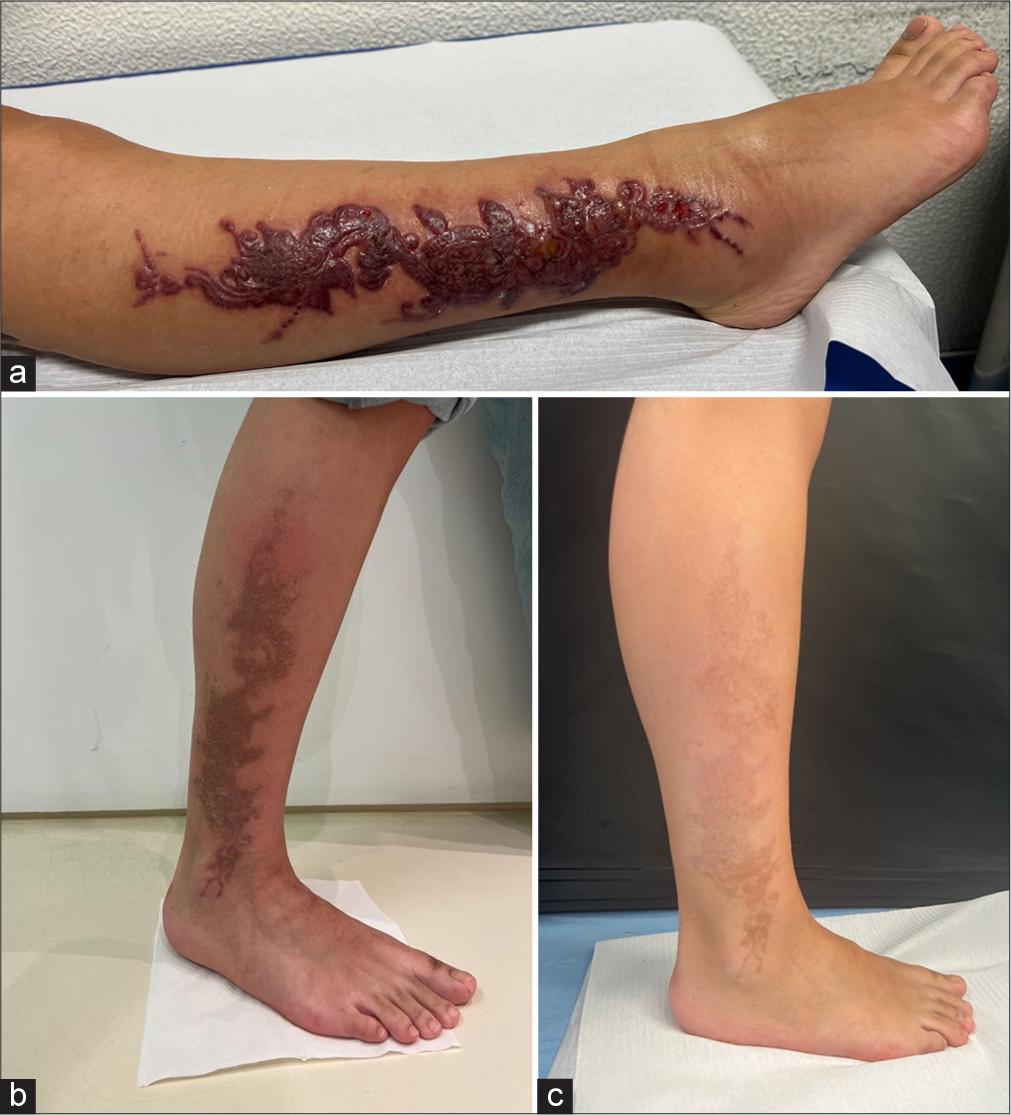Translate this page into:
Effective management of post-inflammatory hyperpigmentation secondary to para-phenylenediamine contact allergic dermatitis using 755-nm alexandrite picosecond laser
*Corresponding author: Joana Vieitez-Frade, Department of Dermatology, Hospital de Santa Maria, Unidade Local de Saúde Santa Maria, Lisbon, Portugal. joanamvfrade@gmail.com
-
Received: ,
Accepted: ,
How to cite this article : Vieitez-Frade J, Mancha D, Correia-Fonseca I, Filipe P. Effective management of post-inflammatory hyperpigmentation secondary to para-phenylenediamine contact allergic dermatitis using 755-nm alexandrite picosecond laser. J Cutan Aesthet Surg. doi: 10.25259/ JCAS_3_2025
Dear Editor,
Henna is widely used in body and hair art coloring. Para-phenylenediamine (PPD) is often added to improve its properties, creating the well-known “black henna.” PPD is a potent allergen that frequently causes allergic contact dermatitis (ACD), which frequently leads to post-inflammatory hyperpigmentation (PIH), that can persist for several months, causing a significant psychosocial impact.1 At present, treatments targeting PIH include depigmenting agents, chemical peels, and laser therapy. Few studies focus on laser treatment for PIH, in which the 755-nm Alexandrite Picosecond laser has demonstrated promising results.2,3
This article describes a case of PIH secondary to ACD effectively treated with a 755-nm alexandrite picosecond laser.
A 15-year-old teenager presented to the emergency room due to pruritic blisters on her right leg [Figure 1a] at the site of a “black henna” tattoo performed in Morocco the previous week. Treatment with oral prednisolone and topical betamethasone resolved the acute dermatitis, and patch testing confirmed strong PPD positivity. After 6 months, significant PIH persisted at the site of previous inflammation [Figure 1b]. The patient underwent two treatment sessions with alexandrite picosecond laser 755-nm (PicoSure®), using 2.34 J/cm2 energy density, 3.1 mm spot size, 10 Hz frequency, and 750 ps pulse duration, at 2-month intervals. Post-treatment care consisted of avoiding sun exposure, emollients, and sun protection (SPF50+). Notably, PIH markedly improved without post-treatment complications [Figure 1c], and the patient expressed high satisfaction.

- (a) Allergic contact dermatitis due para-phenylenediamine on right leg. (b) After 6 months, significant post-inflammatory hyperpigmentation persisted. (c) Significant pigmentation improvement after two 755-nm Alexandrite Picosecond Laser sessions with 2-month intervals.
The 532-nm, 755-nm, and 1064-nm picosecond lasers have shown to be effective in the treatment of pigmentary disorders, acne scars, and photoaging. Unlike millisecond or nanosecond laser therapy, whose effect depends on thermal destruction, the picosecond laser uses the photomechanical effect to fragment the pigment, resulting in minimal thermal damage. This mechanism reduces inflammation and the risk of laser-induced hyperpigmentation, making them particularly advantageous in the treatment of PIH, especially in patients with darker phototypes.3,4 The use of 755-nm Alexandrite Picosecond Laser on PIH has already been reported in the literature.2-5 Zawodny et al. evaluated the efficacy of the 755 nm Alexandrite Picosecond laser in 109 patients with mixed hyperpigmentation, including 13 cases of PIH, using a 750 ps pulse width, 10 Hz frequency, 3.0–3.5 mm spot size, and 2.08–2.83 J/cm2 energy density. This study reported efficacy in Fitzpatrick skin types I-III.4 Similarly, Lee et al. documented significant improvement in a patient with lip PIH after seven 755 nm Alexandrite Picosecond laser sessions using a 2 mm spot size and a 7.25 J/cm2 energy density.5 Finally, Ren and Zhao also reported a case of PIH on the dorsum of the nose treated with 755 nm Alexandrite Picosecond Laser, using 750 ps pulse width, 1 Hz frequency, 3.2 mm spot size, and 2.49 J/cm2 energy density, also with significant improvement after two sessions with an interval of 6 months.2
This case report highlights the potential of the 755-nm Alexandrite Picosecond laser as a safe and effective treatment for PIH, including ACD-induced cases. However, more studies are needed to define protocols as well as to establish their long-term effectiveness in comparison with alternative therapies.3,4
Acknowledgment:
The patient in this manuscript has given written informed consent to the publication of his case details.
Authors' contributions:
Joana Vieitez-Frade and Isabel Correia-Fonseca: Study design. Dora Mancha, Isabel Correia-Fonseca, and Paulo Filipe: Writing and critical review of the manuscript. All authors approved the final version to be published.
Ethical approval:
Institutional Review Board approval is not required.
Declaration of patient consent:
The authors certify that they have obtained all appropriate patient consent.
Conflicts of interest:
There are no conflicts of interest.
Use of artificial intelligence (AI)-assisted technology for manuscript preparation:
The authors confirm that there was no use of artificial intelligence (AI)-assisted technology for assisting in the writing or editing of the manuscript and no images were manipulated using AI.
Financial support and sponsorship: Nil.
References
- Allergic contact dermatitis due to a temporary henna tattoo, a hair dye, and a marker pen. J Investig Allergol Clin Immunol. 2008;18:226-7.
- [Google Scholar]
- A case report on the use of 755-nm alexandrite picosecond laser in the treatment of post-inflammatory hyperpigmentation in the nose. J Cosmet Dermatol. 2022;21:2046-8.
- [CrossRef] [PubMed] [Google Scholar]
- 755-nm alexandrite picosecond laser with a diffractive lens array or zoom handpiece for post-inflammatory hyperpigmentation: Two case reports with a three-year follow-up. Clin Cosmet Investig Dermatol. 2021;14:1459-64.
- [CrossRef] [PubMed] [Google Scholar]
- Evaluation of the efficacy of the 755 nm picosecond laser in eliminating pigmented skin lesions after a single treatment based on photographic analysis with polarised light. J Clin Med. 2024;13:304.
- [CrossRef] [PubMed] [Google Scholar]
- Treatment of melasma and post-inflammatory hyperpigmentation by a picosecond 755-nm alexandrite laser in Asian patients. Ann Dermatol. 2017;29:779-81.
- [CrossRef] [PubMed] [Google Scholar]





